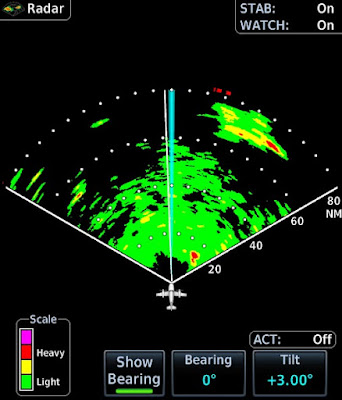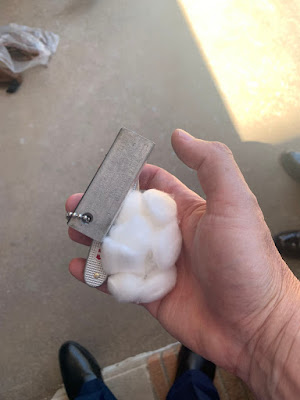Elmer Fudd was famous for his quote, "Be vewy vewy quiet I'm hunting wabbits!!", today I could make as much noise as I liked, I was on the hunt for storms, again... I have some very cool and useful weather avoidance equipment but it is only as good as the operator. It helped us return safely from OKC and Monday it was really helpful avoiding the approaching storms on my way home.
When I awoke this morning there were clear blue skies with storms off in the distance. Yes they rumbled through later but around 9 AM they were just getting going. You can see the big picture above (This is XM satellite radar which is delayed but produced by the large NWS doppler network), some near storms, some light rain starting around 50 miles, and some heavy storms out around 80-90 miles. I headed West and approached the weather.
The close in rain looked impressive during my departure. It is about 40 miles out in the picture. You can see it has some significant vertical development which makes a difference when using the radar. Looking at the big picture above, you can see the near rain has 3 distinct parts and we can clearly see them in the image below. The important controls on the radar are tilt and range.
Bumping up to plus 4 degrees, cleans up the clutter a good bit. Notice the far tail looks like it is not as intense (it looked worse on the 3.5 tilt) but this may not be the case. Since it is further back and I am tilted further up, it may be that my beam is scanning above the more intense rain. At 35 miles there is not much drop off from the earth curvature, maybe 1000' but my beam is pretty wide out that far out, about 5 miles or 25,000' so I may be missing the important part of the storm.
Tilting up to 5.5 cleans up all the ground clutter but it also makes the rain look less intense than it is. Lesson here, over tilting to eliminate all of the ground clutter is a bad idea. You are sending your beam into the top of the storm which is likely above the freezing level and will give you a false impression of the storm intensity. When you are higher up this is less of a problem but you want to accept a bit of clutter to get the best weather image.
Looking out further, there were big storms at 80+ miles (see the first picture). The easiest way to see that far is to drop your beam near the horizon. The horizon is about 60 miles so at 80 there is not much drop off to hide weather. You do need to keep your beam flat at that distance or you will send your energy over the storms. You can see at plus 1 tilt the ground is covering the first 60 miles but we can clearly see the storms at 80 miles and the radar is warning with those red bars that there is more bad stuff off screen. If you want to see in the 0-60 range, you will need to re-adjust the tilt for that range.
We can pick the bean up a bit to reduce the the ground and plus 3 seems to be a good compromise at this altitude. We still have a good bit of clutter and we can see the near rain reminding us we will need to turn soon to avoid it.
Plus 5 looks cleaner still but is a mistake as you are losing too much information. Notice in the image below now that we have moved West and a bit closer to the tail of the near rain (it is only 20 miles), plus 5 is capturing the heavy precipitation and giving us a clean picture. Here is the plus 5 below, zoomed in. When working less than 20 miles or less, you can be more aggressive with the tilt. This is also useful when making an approach over a city where you will get significant clutter which can be hard to differentiate from weather.
The far strong storms and the near storms imaged well but what about stuff in the middle? There was a mass of light rain in the 40-60 mile range. This did not look like much from the cockpit. What did it look like on the radar?
Frankly it is hard to distinguish from the ground at plus 3 though the near and far rain in clear. Tilting up to 4.25 cleans up the clutter but doesn't paint much. We do have the throng storms at 70 miles that let us know we are tilted correctly to see anything big. The reality is we need to get closer to get a better image. At cruise speed I am still 12-13 minutes away with plenty of time to make a course correction depending on what happens as it moves inside 30 miles.
The clouds were starting to build so I made a strategic retreat. This gave me an opportunity to use the radar to image the coast. Pointing down we clearly see the coast. The only odd return is the island that has grown off the mouth of the St. John's river.
We can bring the beam up a bit and look wider. This is a better setting but still too low to be very useful for weather. The coastline with all it's development reflects a lot of energy back. The Red on the left is downtown Jacksonville and the yellow on the right is St. Augustine.
Our island is still there or is it? Not really, there is no new land off the coast of Florida. Just like buildings, large ships at sea are great radar targets. The energy easily bounces off the side of a metal ship. Below is a clearer picture. There are actually 3 ships at anchor, each visible on radar.
On the left you can see the coast and just right of center is likely someone else's radar. When another plane is is heading towards you and sweeps across your radar it makes a radial spike. The radars are smart and use a variety of frequencies, the unit will adjust to ignore the other radar and they seldom show up for more than 1 or 2 sweeps. Talking ships, below is a shot from Monday by Savannah. The left is the coast, the right is more than 25 ships at anchor off Savannah.
I was ready to head in but the clouds had thickened a bit and were lower. Approach was nice enough to provide a pop up IFR which avoided a detour around the clouds. I joined the GPS 32, circle to land 23 as 32 was being inspected by FDOT.
Bases were 1,200' on the approach but much higher over the field. It was a fun approach and I soon had the plane away well before the storms arrived.



























































